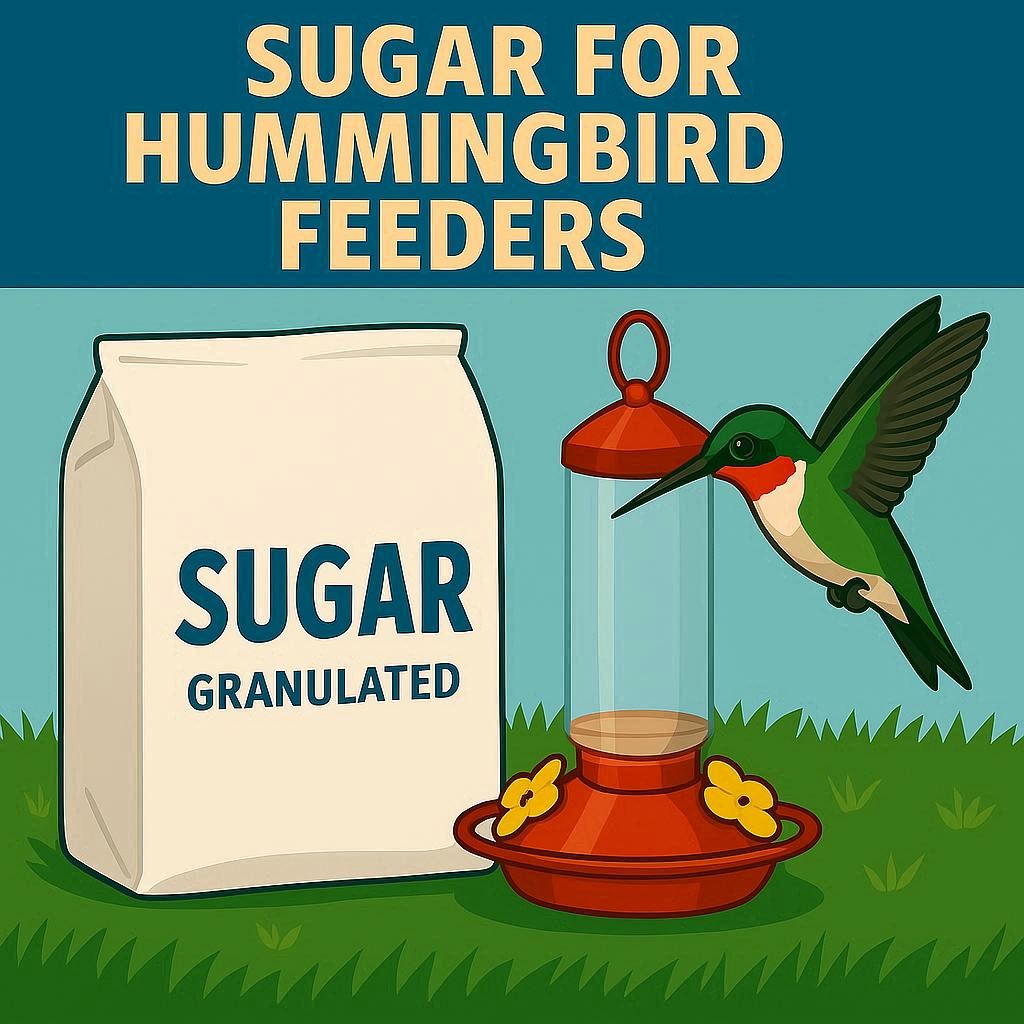
Feeding hummingbirds is a delightful way to connect with nature and support these tiny energy marvels. Making the right sugar nectar is essential to keep them healthy and visiting your backyard. This comprehensive guide covers everything about sugar for hummingbird feeders — from the ideal recipe and preparation tips to how often to change it and common mistakes to avoid.
Why Do Hummingbirds Need Sugar Nectar?
Hummingbirds have incredibly high metabolisms, requiring constant energy to fuel their rapid wing beats and agile flight. In the wild, their primary source of energy is nectar from flowers — a natural sugar solution. Providing a sugar water mixture in feeders mimics this natural diet and helps hummingbirds conserve energy, especially during migration or breeding seasons when their caloric needs peak.
The Best Sugar-to-Water Ratio
The universally recommended recipe for hummingbird nectar is 1 part refined white granulated sugar to 4 parts water. This 1:4 ratio closely approximates the sugar concentration found naturally in most flower nectars.
- For example, mix 1 cup of sugar with 4 cups of water.
- This ratio provides the optimum energy density while minimizing the risk of fermentation or bacterial growth.
In warmer weather or peak activity, you can slightly adjust the ratio between 1:3 and 1:5, but avoid going beyond these limits as it can harm or deter the hummingbirds.
Why Only Refined White Sugar?
- Refined white table sugar is recommended because it is pure sucrose without additives.
- Avoid honey, brown sugar, raw sugar, powdered/confectioners’ sugar, or artificial sweeteners.
- These alternatives can promote harmful fungal growth, contain iron that is toxic to hummingbirds, or contain fillers that harm bird health.
How to Make and Prepare Sugar Water Safely
Step-by-step Guide:
- Measure Ingredients: Choose your “part” (cup, pint, etc.) and measure sugar and water accordingly.
- Boil Water: Boiling helps remove impurities and kills mold spores. Boil fresh water first.
- Dissolve Sugar: Remove water from heat; stir in sugar until fully dissolved.
- Cool Completely: Let the nectar cool to room temperature before filling feeders.
- Fill Feeders: Use a clean feeder; fill it with your homemade nectar.
Note: While boiling is not strictly necessary if using clean tap water and small batches, it is recommended for large batches or if water quality is a concern.
Storing Sugar Water
- Prepare sugar water fresh or store extra in the refrigerator for up to 1 week.
- Discard any stored nectar if you see mold or fermentation.
Cleaning and Maintenance
- Clean feeders thoroughly every 2-3 days during hot weather and at least once a week in cooler seasons.
- Regular cleaning prevents mold and bacteria growth, which can be fatal to hummingbirds.
- Use a mild soap and hot water or a vinegar solution to scrub feeders.
Common Mistakes to Avoid
- Adding Red Dye: Do not add food coloring or red dye. They are unnecessary and potentially harmful. The red parts of feeders attract hummingbirds just fine.
- Using the Wrong Sugar: Never use honey or brown sugar.
- Not Changing Nectar Often Enough: Spoiled nectar produces mold harmful to birds.
Feeding Tips Based on Seasons and Geography
- Along southern U.S. areas like the Gulf Coast, feeders can be set out from mid-February to early November.
- In the mid-latitudes, start feeders from early-mid April and take down by late October.
- In northern states, feeders are best from early May through late September.
Supporting Hummingbird Health Beyond Sugar Water
- Plant native nectar-rich flowers (like bee balm, cardinal flower, coral honeysuckle).
- Avoid pesticides to protect insect prey.
- Provide fresh water sources.
Hummingbird Nectar Recipe
- Ingredients:
- 1 part refined white granulated sugar (e.g., 1 cup)
- 4 parts water (e.g., 4 cups)
- Instructions:
- Bring the water to a boil. Boiling helps sterilize the water and dissolve sugar faster.
- Add the measured sugar to the boiling water.
- Stir until the sugar is completely dissolved.
- Let the mixture cool completely to room temperature before filling your feeder.
- Fill your cleaned hummingbird feeder with the nectar.
- Store any extra nectar in the refrigerator for up to one week.
- Important Notes:
- Use ONLY refined white sugar. Do NOT use honey, brown sugar, raw sugar, powdered sugar, or artificial sweeteners as they can be harmful to hummingbirds.
- Do NOT add red food coloring or dye. The red parts of the feeder attract hummingbirds naturally.
- Change the nectar every 2-3 days during hot weather to prevent fermentation and mold; once a week in cooler weather is acceptable.
- Clean feeders thoroughly each time you change the nectar.
This recipe closely mimics the sugar concentration found naturally in flower nectar, providing the energy hummingbirds need while keeping it safe and healthy
Sugar alternatives for hummingbird feeders are generally not recommended. The safest and healthiest option for hummingbirds is refined white granulated sugar mixed with water at a ratio of 1 part sugar to 4 parts water, as this mimics natural flower nectar closely.
Why Not Use Sugar Alternatives?
- Honey, brown sugar, raw sugar, agave, maple syrup, and artificial sweeteners should be avoided because they can contain impurities or additives harmful to hummingbirds.
- Honey and syrups promote growth of harmful fungi and bacteria dangerous to hummingbirds.
- Brown and raw sugars contain molasses and iron, both potentially toxic to hummingbirds.
- Artificial sweeteners provide no nutritional value and may be toxic.
- Organic sugar is debated; however, scientific consensus leans toward refined white sugar for safety and consistency, though some sources note minimal risk with organic sugar if iron is low.
Summary of Alternatives and Their Issues
| Alternative | Safety for Hummingbirds | Reason to Avoid |
|---|---|---|
| Honey | Unsafe | Promotes fungal growth; sticky feathers |
| Brown Sugar | Unsafe | Contains molasses and high iron |
| Raw Sugar (Turbinado) | Generally Avoid | Contains fillers and iron |
| Agave Nectar | Unsafe | Difficult to digest; promotes harmful fungi |
| Artificial Sweeteners | Unsafe | No calories; possibly toxic |
| Organic Sugar | Controversial, likely Safe | Trace iron content; low risk but less tested |
| Maple Syrup | Not recommended but sometimes used | Expensive; different sugar composition |
Summary
Making your hummingbird nectar is simple and effective: mix 1 part pure white sugar with 4 parts boiled water, cool, and feed fresh every few days. Proper sugar water keeps hummingbirds healthy, happy, and coming back year after year.
Frequently Asked Questions
Q: Can I use honey instead of sugar?
- No. Honey promotes harmful fungal growth and can be toxic.
Q: Do I have to boil the water?
- Boiling water helps sterilize, but if using clean water and small batches changed frequently, it’s optional.
Q: How often should I change the nectar?
- Every 2-3 days in hot weather; weekly in cooler weather.
Q: Should I add food coloring?
- No. Do not add red or any dye.
Q: What type of sugar is best?
- Plain refined white granulated table sugar only.
Q: Can I store extra nectar?
- Yes, in the refrigerator for up to 1 week.
Would you like guidance on selecting hummingbird feeders or planting a hummingbird garden next?
Citations
- https://nationalzoo.si.edu/migratory-birds/hummingbird-nectar-recipe
- https://www.allaboutbirds.org/news/feeding-hummingbird
- https://www.wildliferescue.ca/2024/01/29/year-round-hummingbird-feeder-guide/
- https://www.audubon.org/magazine/hummingbird-feeding-faqs

Hi, There and Welcome to BirdsNews.com, is here to help you learn and care about pet birds. and this blog is a journal of everything I’ve learned.
